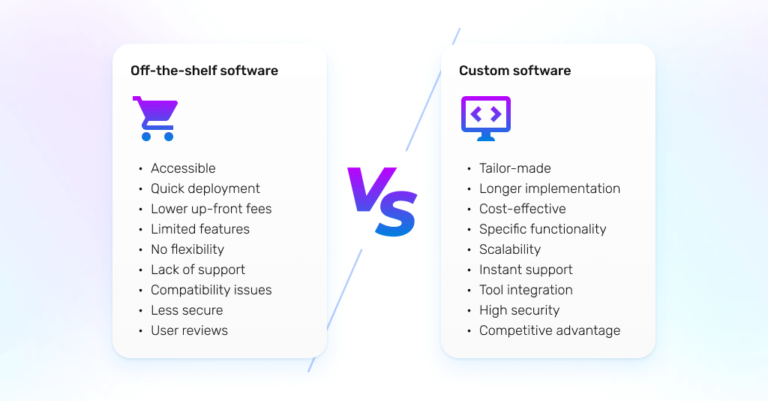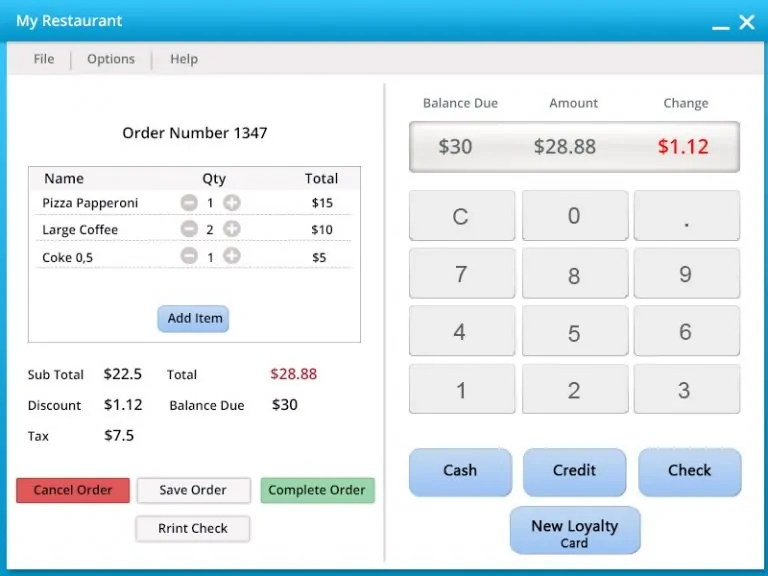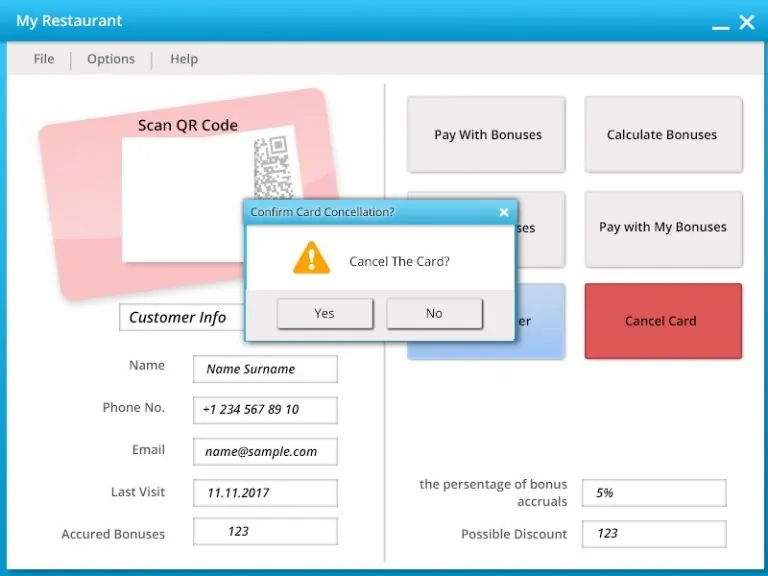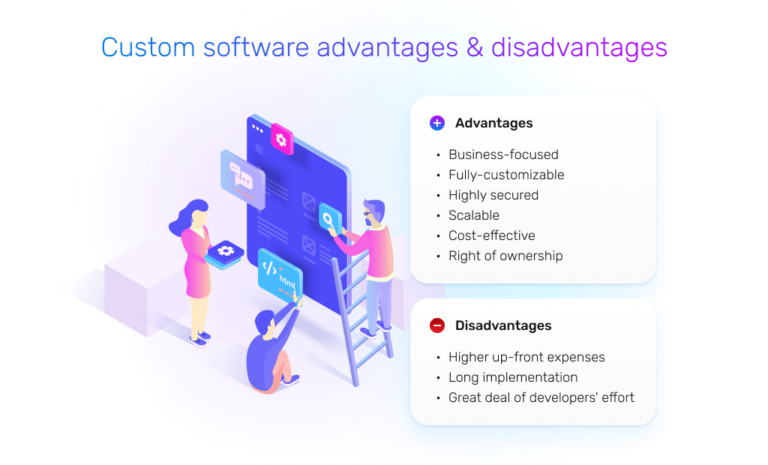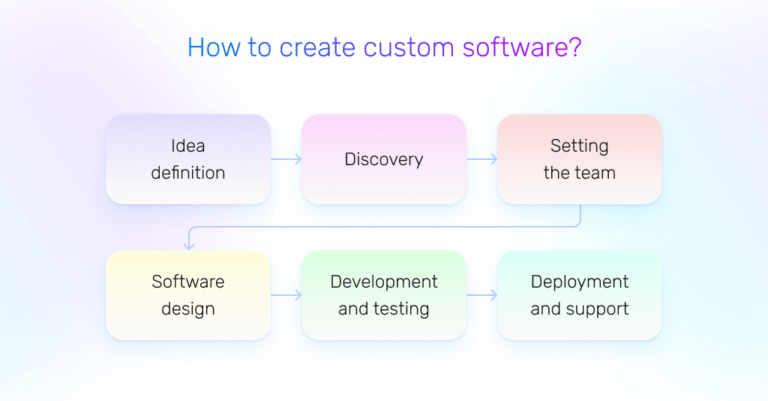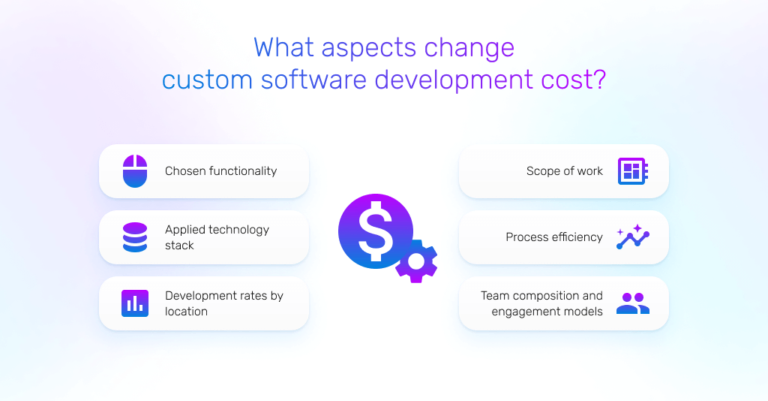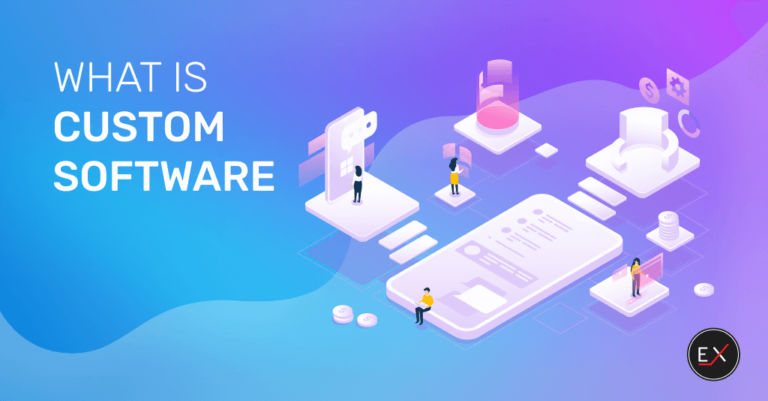
Updated: June 27, 2024
Published: August 29, 2017
– What is custom software?
– How can custom-built software become more popular than out-of-the-box solutions?
– What aspects to consider when starting custom software development?
Along with addressing these and other related questions, we’ll explain custom software concepts and how to use them efficiently for your business.
List of the Content
- What is custom software?
- Custom software vs off-the-shelf software
- What is an example of custom software?
- When to apply custom software development?
- Custom software advantages and disadvantages
- How to create custom software?
- Good practices to streamline the development process
- How long does it take to build custom software?
- How much does custom software cost?
- Conclusion
WHAT IS CUSTOM SOFTWARE
It is hard to find some business that doesn’t use software for addressing various needs. When the team looks for solutions, it could be challenging to differentiate involved concepts and make the final choice.
First off, let’s provide the custom software definition. It is the solution specially developed for a particular user or organization, in contrast with broadly used mass-market apps. But what is customized software, then? Is there any difference between these two concepts? Well, the software customization definition differs a little. It means optimizing the existing applications according to the user’s requirements and expectations.
Despite the diverse spectrum, the software market often is not able to meet the demands of all varieties of modern management and business processes. It comes as no surprise that many companies would like their information system to have some unique features. In these conditions, the company has to call on IT specialists to adapt to the concerns of the existing business processes or create entirely new ones.
The question, what is custom software, cannot be answered explicitly as there are various definitions of it. Therefore, custom software definition also expands to include solutions that have been designed to run on specific hardware. For example, car manufacturers simply have nowhere to turn to purchase programs for the vehicle on-board computer. Obviously, they have to develop these kinds of solutions by internal or external IT structures while heavily relying on hardware specifications.
If you wonder what teams can get with custom development, it is necessary to find the comprehensive answer to “what is custom software”. Development isn’t an easy task, but different successful custom software examples show that it’s worth it. When you acquire the bespoke software, you get many crucial functions you need. You don’t have to look for compromises when choosing applications for work-related purposes. In general, what gives you the best custom solutions – you can get them at a reasonable price. On the other hand, custom software development requires time and money, so even the most acceptable price can be prohibitively expensive. However, if your bespoke software is developed on a tight schedule, it saves a significant part of the time and finance expenses.
Many companies that provide custom development offer proposals, which make your business benefit. They listen to your needs and, matching these needs to your actual requirements, design bespoke applications. These organizations have enough talented and professional specialists that work diligently to meet your requirements. Altogether, all you need to do at the beginning of your project development process is to clearly understand what custom software is and why it is good to use it.
CUSTOM SOFTWARE VS OFF-THE-SHELF SOFTWARE
Continuing on the question of what is custom software, it is a great idea to draw a comparison with the off-the-shelf solutions. It covers a number of important aspects for discussing and getting a better understanding. Have you thought about why teams decide to start development from scratch when they can choose the ready-to-use alternative?
The market has a wide range of solutions through the needs of companies, and their users are quite different. Every organization needs to streamline its business processes, manage data, arrange communication with customers, etc. Though specifications and ways to implement always remain different. The same way is with the applied software. It’s obvious that the solution for internal processes would be different from the external ones. Sometimes teams can apply several types of software to meet all the needs or integrate them into the unified system.
Besides, even businesses from the same industries won’t need to apply the same approaches. If some companies choose to sell goods on the eCommerce platform, others might prefer to build their own branded eCommerce app.
But what are the main reasons to support the team’s final choice?
The duration of implementation – Addressing the question of what is custom software, it’s obvious that its implementation requires time for development and deployment. It won’t be completed within days or even weeks. Software development from scratch covers the overall process, from identifying specific needs to delivering necessary solutions. In contrast, off-the-shelf software is often chosen for quick deployment. It takes less time as the team just needs to purchase the software, complete installation, and get ready to use it.
Cost – If we consider the initial costs, off-the-shelf software is obviously cheaper than developing a bespoke solution. As it’s built for the mass market, the overall cost is basically covered by numerous users. However, we shouldn’t forget the fact that the team also has to estimate monthly costs, additional user subscriptions, new paid features, etc. And in many cases, it could cost more than even the custom software solutions. The distinctive advantage of bespoke products is cost-effectiveness to eliminate wasting resources for some unnecessary functionality or unexpected expenses. We’ll go into more detail about the custom software cost in the next paragraphs.
Flexibility – A good reason to give it consideration as every team looks for the best solution while remaining flexible about arising needs. Therefore off-the-shelf software is far behind custom-made software. Taking the long-term perspective, it often turns out that the teams lack some essential functionality, though you won’t be able to add it on your side. It becomes hard to support software advancement due to the growth of your business. In fact, the team gets only the packaged features that may not correspond to your needs later. Whereas building bespoke software allows the team to scale the product due to arising requirements. Moreover, it comes with personalized support specifically for your software.
As business needs vary from organization to organization, their choices are also different. Though we always recommend looking from the long-term perspective and choosing the solution that will grow along with your business. Following the good market practice of building custom software shows that development efforts and up-front investments easily become advantageous and cost-effective over time.
WHAT IS AN EXAMPLE OF CUSTOM SOFTWARE
Discussing what is custom software, it’s interesting to check an example of a bespoke solution. To give you a clear picture of it, let’s demonstrate software developed by EXISTEK for a cafe franchise. We’ll briefly look through the architecture, development process, and solution implementation.
Interested in more projects by EXISTEK?
We’re a custom software development company that has over a decade of experience helping our US and European partners to solve their business challenges.
The following is an example of the exclusive requirements given by a client company. You could find off-the-shelf solutions that do the same sort of things as scanning the QR codes program or processing loyalty cards. However, the client was expecting to see a program that unites the features and will also have its company branding.
The customer was expecting EXISTEK to devise and implement an easy-to-use solution for non-technical users that would enable the production of loyalty cards and quick, reliable scanning and tracing of loyalty card usage. The Customer Loyalty Software also had to be integrated with the existing POS to allow staff to apply discounts using loyalty bonuses. First, we needed to implement the real-time processing of the QR codes and Images. Also, there should have been a database of customers with data about bonuses amount, which included the automatic calculation of the discount and the percentage of bonus accruals.
That’s how we’ve overcome these challenges and implemented the required functionality:
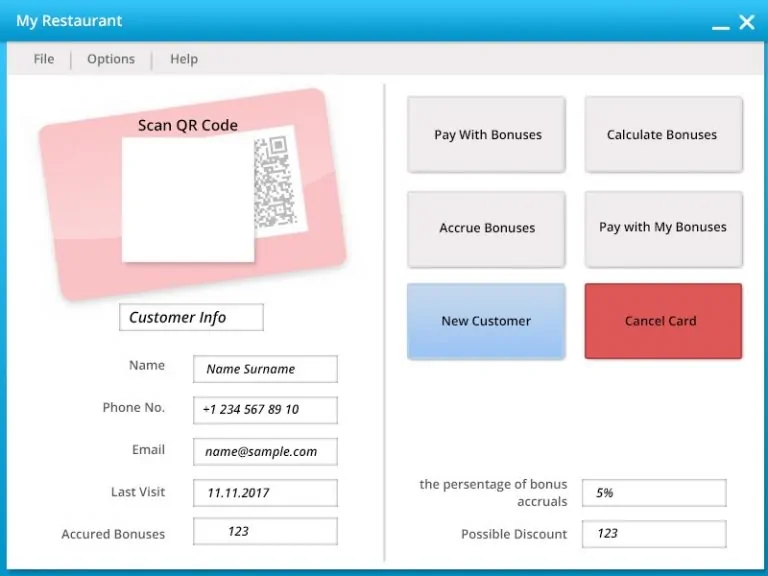
The solution for the implementation was found in a combination of image processing libraries for image processing and .NET.
Considering this particular example, you probably want to know what is custom software advantage in this case. Here’s a short list of benefits and features delivered to the cafe franchise by this project:
- very little downtime and processed thousands of loyalty cards;
- did not involve costly hardware solutions or contract lock-ins;
- real-time processing of the QR codes and images;
- database of the customers with data about bonuses amount;
- allowed managers to accrue bonuses to the customer’s card for each order;
- automatic calculation of the discount and the percentage of bonus accruals;
- possibility to pay a check partially or completely via previously accrued bonuses.
This project explicitly illustrates the questions of what is custom software and what is an example of bespoke software. In this case, the customer had to acquire a custom-developed app due to specific requirements instead of simply buying an off-the-shelf solution. As you can see, the wide range of features is narrowly focused. You can barely find a solution to your similar requirements. In the end, the client has obtained all-in-one hospitality and loyalty tool that completely fills in the workflow gaps. Moreover, the cafe franchise had exclusive ownership of the application, which meant zero licensing costs regardless of the number of users, accounts, and terminals.
As a result, the cafe management, staff, and visitors really appreciated the final product. The final product required almost zero maintenance and was extremely reliable. It was a risky move on the customer side, but the relatively high price resulted in greater financial and reputational earnings from a long-time perspective.
WHEN TO APPLY CUSTOM SOFTWARE DEVELOPMENT
When you purchase mass-market apps, you hand over the node to that software. As for you, you take the middle path concerning time, effectiveness, and working capacity. That means that you will have to use it even if it doesn’t fit some of your requirements. It’s related to both cases when it has the functionality you don’t plan to use as well as it lacks the desired ones. Therefore, it’s better to tilt forward towards custom software development, as you’ll be certain it will meet all the outlined requirements and needs of your company.
Here are some advantages of bespoke solutions:
- No excessive functions;
- Cost-effectiveness;
- The high degree of flexibility
- Time-saving efficiency;
- Easiness to learn and use.
Let’s figure out what is custom software best practice for a better understanding of this process. The most obvious purpose of starting a custom development project is bringing profits to a company via the better organization of everyday processes and tasks. First off, it eases the overall workflow, having only the features that are useful for this area while having no extras that will have little to no use in the future. For example, applications developed for the hospital will include personnel records, past medical history, visit data, etc. Every point mentioned above helps the staff that works with the solution and the patients be aware of the healing regimens particular to that or another subject. Of course, you may find the publicly available apps, but most of such tools are unified, which means they will not necessarily address all your needs. Besides, any software requires the highest security level while being compliant with all the necessary regulations. Custom-built applications are known for great security and are less vulnerable to attacks.
Finding out what is custom software development and what it relies upon, we’ve come to the conclusion that it’s improving internal workflows. Besides, it has the appearance for the customers’ use – these are business and marketing opportunities. For example, the cafes or restaurants may not have only the apps that will satisfy the internal needs, but the ones for visitors’ use as well. This application may contain the full list of the dishes available for a restaurant with the accompanying prices, so the client will be aware of the meals available. Besides, it may work as the “discount voucher” so the visitors are uncharged of excessive items, but with a friendly tool, which wins users over. Supporting the presence of your business on different platforms like the web or mobile allows customers to reach your products and services on different devices. Simply put, the best examples of bespoke software use are those cases when companies really take care of the comfort of both their staff and customers. As for the savvy entrepreneurs, the correct, both-side (internal and external) use of the bespoke solutions will show terrific marketing graphs. Simplifying the business workflows within your organization, you can also build efficient communication channels with your customers. Besides, business custom software completely relies upon your strategy and oversees the unique needs of your staff and user experience.
Have a great idea for custom software development?
Feel free to contact EXISTEK. Our team has first-hand experience and knows how to implement your idea into a successful product.
CUSTOM SOFTWARE ADVANTAGES AND DISADVANTAGES
We’ve briefly mentioned the bespoke software advantages, but here we will take a closer look at the advantages and disadvantages to ascertain a clear custom software definition.
Nothing has only positives. Custom apps have disadvantages as well. The first and main being the cost of development. There is no doubt that the application that’s tailored by your instructions and fits all the nuances of your business shouldn’t be so simple as that. Be ready that the upfront cost for its development will be high as well. In fact, disadvantages like the upfront costs shouldn’t affect your decision on business improvement. The high cost justifies itself after implementation. There is no more need to extend the license of the commercial applications that could be the basis of your work management. The perfectly adjusted apps will rapidly boost your business development due to their systemic fit but not business fitting to the applications used.
The answer to the question “what is custom software advantage?” is that you get exactly that functionality that you want there to be present. You may object that a ready-to-use solution can contain a huge diversity of functions, even the extra features. But let’s be clear, most functions of the unified apps are never used and just go to waste. Why would you pay for the expensive license if you only use half of its features? Why would you buy a flagship smartphone if you use it for phone calls only? These are basically the same things.
We can surely answer “what is custom software benefit” now. It’s that you don’t rely on someone else’s success and stability. The business processes will still depend on the regularity of updates or the quality of support. If the company-provider of your licensed application has collapsed, at best conditions, this means the end of support and updates, including security. In the worst conditions, you’ll end up without a working cloud platform, which may also ruin your working process. Another custom software definition is a warranty for the security of your business and its processes.
Exclusive ownership gives another significant advantage – a high-security level. It’s hard to imagine something more important in 2021 than information security. Small and large enterprises, including the financial and healthcare sectors, prefer to use the tools developed especially for them. It’s harder to find exploits and security breaches in closed ecosystems simply because it’s much more complicated for hackers to get their hands on such software to plan cyber attacks.
Continuing the topic “what is custom software”, it is essential to understand one more aspect working to your advantage. The team has all the tools to deliver a unique product that could differentiate your business from others. Besides new features, the team has the opportunity to focus on delivering a great user experience and functional and impressive designs. It’s an essential task for companies that want to support the uniqueness and consistency of their products. Branded applications enable continuous communication with prospects and customers and create their own environment for interaction.
HOW TO CREATE CUSTOM SOFTWARE
Finding out what is custom software isn’t possible without learning the development process itself. As the product owner, the company has to set their own development team or apply for the services of the third-party providers. In both cases, they need to be fully involved in the delivery process. Active cooperation on each development stage is an integral part of successful product development.
As long as bespoke software is created from scratch, the company isn’t able to skip any stage. The more effectively you arrange the process, the better product you get at the end. Although teams work with different types of software, specifications, and complexity, they will undergo the same fundamental steps of software development.
- Get the idea – That’s a starting point to develop the understanding of your project and define needs. The custom software idea outlines the primary requirements and forms the vision of the future product. Every team starts with prioritizing needs and how they can be efficiently implemented. In short, it’s about answering what is custom software for your business and what to use it for.
- Define the strategy – Comprehensive analysis helps to analyze, document, validate and manage software requirements. It involves defining the type of software, agreed-on features, chosen tech stack, required developers, and set timeline for its implementation. The SPS document describes the software logic and outlines the next development steps.
- Set the cross-functional team – The overall development process relies upon not only the work of developers but specialists such as UI/UX designers, project managers, QAs, UI/UX designers, business analysts, etc. Depending on the project specification, you’ll be able to choose specialists proficient in a required field or technology. Moreover, not every company has an in-house team of developers or is ready to hire them on a regular basis. Many of them find outsourcing the project either partially or completely quite beneficial.
- Design custom software – UX/UI designers are responsible for the visual design and the ways to organize user workflows within the software. It starts with creating mockups to see the screen layouts and prototypes to simulate the software behavior. Simple and clear designs should always remain among the main requirements. In addition, custom software always comes with unique designs as it is specially developed for your business.
- Develop and test – Every team will deal with the infrastructure setup, backend, and frontend development. They can set the process individually based on the chosen development approaches, used tech stack, and applied solutions. For example, cross-platform development allows the team to deliver the product faster while saving time and resources. The common thing is that the work of backend and front-end specialists remains tightly connected and goes in parallel with testing by QAs.
- Deploy and support – Once the team launches the product for its customers, they will watch the user behaviors, use the analytics to spot necessary improvements and updates. In fact, it is the main benefit of custom-built software to have the possibility of scaling and advancing due to the appearing needs.
GOOD PRACTICES TO STREAMLINE THE DEVELOPMENT OF CUSTOM SOFTWARE
Building custom software can be a complex and challenging process, but following good practices can help ensure success. Here are some additional explanations of the commonly used practices:
- Clearly define project scope and requirements with the client. Before starting any development work, it’s essential to clearly understand what the customer wants to achieve with the software. This includes defining the project’s scope, requirements, and goals. Work with the client to create a detailed project brief outlining what the software will do, who it’s for, and what features it needs. It allows the team to avoid misunderstandings and ensure that the project stays on track.
- Choose a suitable development methodology based on the project’s nature and requirements. Different projects require different development methodologies. For example, Agile is a good choice for projects with changing requirements, while Waterfall suits projects with fixed requirements. When choosing a methodology, consider the project’s scope, timeline, and team size.
- Develop a detailed project plan with timelines, milestones, and deliverables. A project plan provides a roadmap for the development team and ensures that everyone is working towards the same goals. The plan should include timelines, milestones, deliverables, and a breakdown of tasks and responsibilities.
- Establish effective communication channels with the client, stakeholders, and team members. Good communication is essential for any successful software development project. Set up regular meetings with the client and stakeholders to inform them of the project’s progress and gather feedback. Use collaboration tools like project management software, chat apps, and video conferencing to keep the team connected and working efficiently.
- Use a version control system to manage the codebase and collaborate with other developers. Version control systems like Git allow developers to work on the same codebase simultaneously, excluding overwriting each other’s changes. This makes collaboration more efficient and reduces the risk of errors and conflicts.
- Conduct regular code reviews and testing to ensure quality and minimize errors. Code reviews and testing are essential for catching errors and ensuring that the software is of high quality. Set up a review process and ensure that all code is thoroughly tested before release.
- Ensure the software is scalable, maintainable, and compatible with relevant platforms and systems. The software should be designed to handle future growth and be easy to maintain and update. It should also be compatible with relevant platforms and systems to ensure interoperability and reduce integration challenges.
- Provide accurate documentation and training to clients and end-users. The software should be well-documented to help clients and end-users understand how to use it. Provide user manuals, guides, and training sessions to ensure that everyone can use the software effectively.
- Follow industry best practices and standards for software development and security. Ensure that the software follows industry specifications and standards for development and security. This includes following coding standards, using secure coding practices, and adhering to relevant regulations and standards.
- Continuously improve and update the software based on user feedback and changing requirements. Software development is an iterative process, and there is always room for improvement. Gather feedback from clients and end-users and use it to improve the software over time. Keep an eye on changing requirements and adjust the software as necessary to ensure that it continues to meet the needs of its users.
Setting up a well-organized development process becomes easier by choosing the right approaches and following the experience of other successful projects.
As we discovered what is custom software development process, and the good practices to follow, it is time to find out the timelines required for the software delivery.
HOW LONG DOES IT TAKE TO BUILD CUSTOM SOFTWARE
Most of you won’t be surprised if we say that it’s a common question to ask when considering custom software solutions for your business. Every team wants to know how long does it take to build custom software and when they will be able to use it. Even though it is obvious that it requires some time, companies are always interested in making accurate estimates to understand their actual timeframes. Besides, such details can bring more clarity to the process and often find possible ways to streamline it.
Provided that the team has a detailed analysis of project requirements and development approaches, they will have more comprehensive answers here. The thing is that you aren’t able to receive one correct answer here. Some businesses need to go with the development of complex solutions like ERP to automate numerous processes. Others look for extending user experiences and building a simple mobile app that addresses basic user needs. As a result, the projects vary greatly, as well as the duration to implement them.
The project timeline depends on such aspects as the type of software, its complexity, chosen technology stack, team composition, etc. It is evident that everyone wants to build solutions in the shortest possible time. But from our experience, we can say it is good to look for some ways to streamline development, but you should forget about the efficiency of the software development. The best market practices show that you don’t need to hurry the process up. It is better to develop a workable strategy and apply suitable development approaches. For example, the teams can always start with MVP development for idea validation and faster launch.
How to launch successful software with MVP development?
Find more details on what is MVP development and how your business can benefit from it.
In order to find out what is custom software timeline for different projects, we suggest checking a few estimates for the software with the basic functionality.
Web development (8+ months)
- Discovery & UI/UX design (4-6 weeks)
- Custom development (20-24 weeks)
- Post-launch support and updates (1 week and continuing)
Mobile development for both iOS and Android (6+ months)
- Discovery & UI/UX design (4-6 weeks)
- Custom development (16-20 weeks)
- Post-launch support and updates (1 week and continuing)
ERP development (9+ months)
- Discovery & UI/UX design (4-5 weeks)
- Custom development (24-28 weeks)
- Integrations (4-6 weeks)
- Post-launch support and updates (1-2 weeks and continuing)
CRM development (7+ months)
- Discovery & UI/UX design (4-5 weeks)
- Custom development (18-22 weeks)
- Post-launch support and updates (1-2 weeks and continuing)
Getting back to the question “what is custom software benefit”, you remember that developers choose it for better flexibility. They can adapt development approaches due to specific project needs as well as shorten the timeline considerably. For example, hybrid development of a mobile application speeds up the duration by twice. With the introduction of cross-platform frameworks, the team doesn’t need to create separate iOS and Android apps but shares 90% of the written code.
Also, it’s worth noting that the development stage is the most time-consuming. If the discovery or design stages are completed within almost the same time, the required duration for backend setup and frontend implementation will depend on the project complexity. Moreover, it can rely on the way you set the team. The group of UI/UX designers can complete the custom software design faster than only one designer working on it. Experienced developers are more productive and faster in completing tasks in comparison with ones new to the required expertise. Also, the team that worked together before can deliver products faster as they know the strengths and weaknesses of each member. These are just a few examples but can easily make a difference to your project.
HOW MUCH DOES CUSTOM SOFTWARE COST
Finding the answer to “what is custom software benefit”, some teams could question its cost-efficiency. Of course, it’s quite important to give up-front expenses lots of consideration and find how reasonable it’s for business. However, we often forget that they will own the solution and use it to their own advantage. In contrast, off-the-shelf software has low initial costs, but you never know how its fees can change, or you might need to purchase additional features in the future. Besides, with the growth of the business, teams find it difficult to meet rising needs with the same solution as at the beginning. Custom software solutions can be advanced step by step and focus on business-specific needs.
Along with defining project requirements, the team is able to estimate the actual cost of the outlined solution. It includes the expenses on the development process itself and further costs to maintain and update the solution. The average expenses on custom software support per year could make up 15 percent of the development cost.
But how much does custom software cost? You won’t find the answer provided that you figure out the following details. Firstly, the team has to prioritize functionality for the first release. Secondly, they choose the technology stack and look for specialists of the necessary expertise. Also, they can negotiate the developers’ rates due to experience or the location of the specialists. Last but not least is the project complexity. The more complex solutions, the longer developers work on them, thus increasing the final costs.
Another decisive factor is the engagement model you choose for the collaboration with the development team. If it’s regular engagement, the company needs to cover all the employee’s matters like the salary, accommodation, social security, employee benefits, etc. Some teams apply for services of freelances, thus paying just the fixed price per hour. It can be good for completing simple and one-time tasks, but it isn’t workable for a long-time perspective due to a lack of control, weak IP protection, and low guarantees. The next option is to use the services of third-party providers that have experience with the solutions you’re looking for. That is the most advantageous approach as they will be able to arrange the cooperation the way you like. You can decide on outsourcing the particular tasks or project development completely. The hired developers can become a great extension of the in-house team, or the provider helps to set a dedicated team on their side.
Continuing on the topic of what is custom software cost, we’ve checked the hourly rates of the specialists in popular development locations. As a result of simple calculations, you can see that it can be one of the options to cut expenses. But the main requirement here is not to abandon quality for the lower prices. It is a fact that experienced developers have to be paid accordingly to deliver good products at reasonable prices.
| North America | Western Europe | Eastern Europe | Middle East | Latin America | |
|---|---|---|---|---|---|
| Project manager | $ 50-110/hour | $ 50-110/hour | $ 40-60/hour | $ 25-50/hour | $ 40-100/hour |
| Business analyst | $ 70-110/hour | $ 60-100/hour | $ 40-70/hour | $ 25-50/hour | $ 50-70/hour |
| UI/UX designer | $ 60-130/hour | $ 50-110/hour | $ 30-40/hour | $ 20-35/hour | $ 25-35/hour |
| Back-end developer | $ 80-150/hour | $ 80-160/hour | $ 55-80/hour | $ 25-45/hour | $ 40-80/hour |
| Front-end developer | $ 80-150/hour | $ 80-130/hour | $ 45-70/hour | $ 24-45/hour | $ 35-70/hour |
| Mobile developer | $ 80-170/hour | $ 70-160/hour | $ 50-80/hour | $ 25-55/hour | $ 35-80/hour |
| QA | $ 40-60/hour | $ 40-60/hour | $ 30-40/hour | $ 15-25/hour | $ 25-35/hour |
Looking for more details
Download the report “2020 Global Custom Software Development Rates” to learn more about the prices for offshore projects and consolidate your understanding of what is custom software.
Using the average rates of required specialists, we received the following estimates for the projects we’d also used for calculating the timeline.
Web development
- Custom software cost – $210 000
- Maintenance, support, and update cost per year – $31 500
Mobile development for both iOS and Android
- Custom software cost – $140 000
- Maintenance, support, and update cost per year – $27 000
ERP development
- Custom software cost – $250 000
- Maintenance, support, and update cost per year – $37 500
CRM development
- Custom software cost – $200 000
- Maintenance, support, and update cost per year – $30 000
CONCLUSION
The bespoke software brings results only if you find a proven vendor with an experienced team, which takes into consideration all of your requirements, starting from the very initial development phases. The quality of the custom software should be above grade. To reach that, the development team should include well-organized customer service and provide you with technical assistance.
In this article, we’ve given the answers to such questions as what is custom software, how to create custom software, and how much does custom software cost. Besides, now you’re aware of custom software definition and its advantages and disadvantages. Thus, applying such a working scheme in your business helps your project benefit greatly.
Have more questions or need professional assistance?
EXISTEK is a custom software development company with wide-reaching expertise in various industries, capable of building software solutions of any complexity from scratch.
Frequently asked questions
What is custom software?
That is a custom-made solution specially designed and implemented for a particular organization. The main focus is addressing business-specific needs and personalized approaches via tech solutions.
What are the advantages of custom-written software?
Custom software development presents a number of distinctive benefits. It helps businesses to improve productivity, efficiency, and customer experience. The main advantages include the following:
Business-focused
Fully-customizable
Highly secured
Scalable
Cost-effective
Market-competitive
Who needs custom software?
The great thing about custom software solutions is that they can meet any type of business needs and requirements. They’re always developed with project-specific objectives in mind and vary due to the tech specifications and development approaches. Either small organizations or market-known aggregators can build an efficient solution to their advantage.
How much does it cost to develop custom software?
It might be a tough question to answer as it really depends on the project. As long as the company decides on building software from scratch, they work on implementing the specific solution. For every team, it will differ in the scope of work, features, development approaches, etc. Therefore, the final custom software cost varies from project to project. On average, the cost of custom-made software fluctuates between $50 000 and $250 000.

